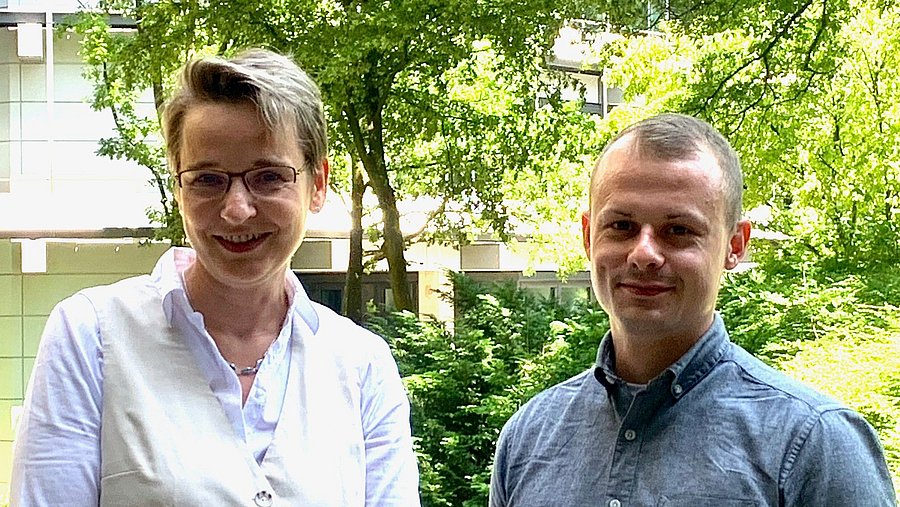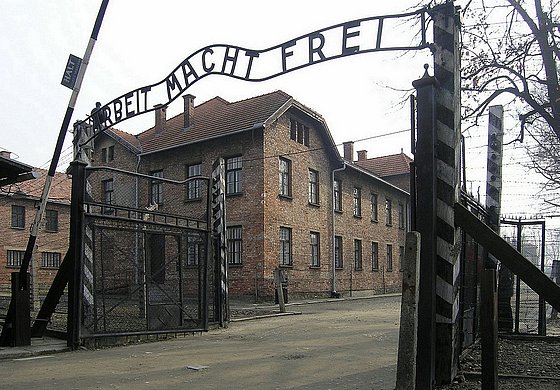
Memorial Education at the Auschwitz Memorial Site
Prof. Dr. Juliane Brauer, Dario Treiber / History
Photo: UniService Transfer
Memorial education at the Auschwitz memorial site
Excursion of the Bergische Universität with the Carl-Fuhlrott-Gymnasium breaks new ground to teach students and pupils how to deal with the history of the Holocaust.
In mid-August, under the direction of historian Prof. Dr. Juliane Brauer and her research assistant Dario Treiber, an unusual excursion with students of the Bergische Universität and pupils of the Carl-Fuhlrott-Gymnasium to the Auschwitz memorial will begin. A total of 15 mainly student teachers and 25 students from the ninth year of high school, which has just ended, have been intensively studying the topic of the Holocaust in Wuppertal over the last few months and are breaking new ground in memorial site education in specially prepared workshops. "Memorials are so many things," Brauer explains, "they are cemeteries, museums, archives and, at the same time, places of learning. To combine this whole multitude of functions is a huge challenge for memorial work, and in the process these learning sites are often reduced to democracy learning." This is reflected in the fact that learners are sent there so that they come out as better democrats. "That's often how memorial sites work, but it usually doesn't help individual engagement." For historical learning, he said, that moral context, that normativity behind it, is quite difficult and tends to block learners. "We've been working to break down that normative claim," says the professor of history and its didactics. She says it's not about what you have to learn and feel in this place, or how you leave the place in the end, but rather what each and every person needs individually for themselves and takes away as a subjective learner. "And that's how we understand didactics, thought from the subject. The individual must position himself or herself in order to recognize something for him or herself and not to adopt something that has been predetermined," Brauer explains.
Carl Fuhlrott High School becomes cooperation partner
The biggest organizational challenge was first to determine a time period that was suitable for the school and the university, because, Brauer explains, "You have to know that a cooperation with a school is challenging. There is a different rhythm, different conditions, schools work differently, have different vacations and the day is also structured differently. Nevertheless, it all worked out wonderfully." The groundwork for this came from Christian Kuchler, a colleague in Aachen, Treiber reports, who had been working on field trips to Auschwitz by German schools and sent the organizers a list of Wuppertal schools that had conducted site visits in the past. Treiber contacted all of them, and Carl Fuhlrott Gymnasium (CFG) quickly emerged as the perfect cooperating school. "The CFG is our ideal match, so to speak, because we needed a class at the beginning of the 10th grade that had discussed Nazi history in the 9th grade," says Brauer, "in addition, the people in charge also kept mirroring their enthusiasm for this project to us." Both students and pupils applied to take part in the excursion with a letter of motivation.
A year and a half of preparation culminated in ...
But how do you convey the history of the Holocaust to young people in the 21st century? The team of lecturers at Bergische Universität offered two matching courses in which the students, who were divided into five working groups of three people each, prepared for their workshop offerings in order to carry out memorial education activities on site for the school students traveling with them. "In terms of content," says Treiber, "we proceeded with the prepared courses in such a way that, on the one hand, the aim was to give the students historical knowledge about the history of the concentration and extermination camps but also the history of the Auschwitz memorial and, on the other hand, to delve deeper into the subject of memorial site education." This included, among other things, discussion of the concept of remembrance culture, functions of memorial sites, concepts such as dark tourism, and discussions on the topic of emotions and historical learning. Because this is also something that needs to be considered, Brauer explains, such a place can be overwhelming, and one has to ask oneself how a memorial and how the visitors* deal with it? One circumstance that challenged the two organizers was the fact that students were apprehensive about their first encounter with the site and also about their responsibility to the students*. "The students who would eventually come along were initially unsure because they hadn't been to the place themselves and were asking themselves, 'What does this do to us? `" Brauer explains. That's why the young workshop leaders were given a coach to help them create the necessary group dynamics and practice reflection methods with them. "Our last block seminar showed that it works. We have a great group there," says the scientist.

Main entrance gate of Auschwitz concentration camp.
(Wikimedia Commons, CC-BY-SA 3.0)
... the excursion
In Auschwitz, the excursion participants will first take part in two guided tours of the Auschwitz I Memorial and the Auschwitz / Birkenau Memorial. "But then, above all, we have a lot of time on site, which the students will use to approach the topic with the students* from different perspectives," says Treiber. "We're going to Auschwitz now in August, and then this place may not show up the way the students expect it to. It will be sunny and green. How do we encounter the place now? How can we build a bridge between us today and what happened there?" The students then work at this point with their prepared workshops. "Then the creative methods come into play to help process the subject matter," Brauer continues. "These are not traditional methods they want to work with, but they are doing something completely new."
Story starts from myself
"One group, for example, does digital storytelling, which means they take photos themselves, work with sources in the form of digitized interviews, photos, texts of various kinds or drawings," the researcher explains. "With these source portfolios that the students have prepared, the students* are now supposed to tell a digital story, starting from themselves. So we're here today, we've been given a tour of the place, and we're asking ourselves, what's important to us now? What do we still want to explore? And that's being filmed." Another group is working with music, which also had an important function in the concentration camps, as both the Birkenau men's camp and the women's camp each had an orchestra. "The goal is that they might write fictional letters to the male and female musicians who survived." They also work with photos. Says Treiber, "One group is working with photographs, both historical photographs but also photographs that the students take themselves during the tours, to make different perspectives on the place visible." Still others work biographically with life stories of Wuppertal Jews whose names have been immortalized on the so-called Stolpersteine (stumbling stones) in Wuppertal's city center.
Students in the role of teacher
In the workshops, the students temporarily slipped into the teaching role. This required additional strong guidance, especially since some of the facilitators are only barely two to five years older than the school-based workshop participants. "There, hopefully over time, we have provided enough confidence so that we are both now 'just` there. They now feel saddle-sure enough to take the teaching position. They have also already met the 9th grade students, formed groups, so they are also in contact with each other. Our challenge now will be to accompany and observe this collaboration well," Brauer says. "The work was and will be very emotional once again, so we will look afterwards if and how we want to present it. What's important first and foremost is a productive and self-directed engagement with the subject."
Uwe Blass
Prof. Dr. Juliane Brauer teaches history and its didactics in the Faculty of Humanities and Cultural Studies at the University of Wuppertal. Her research interests in the field of history didactics are emotions and historical learning, music in history education, imagination and historical learning, and digital historical cultures. For Modern and Contemporary History, she researches and teaches primarily on the history of divided Germany.
Dario Treiber works as a research assistant in the team History and its Didactics.
